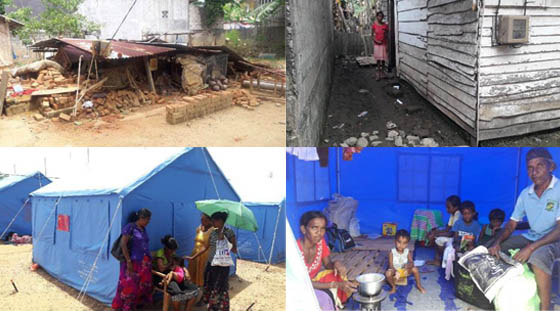
Background
Extreme weather conditions prevalent in May 2016 in Sri Lanka resulted in severe floods and landslides affecting 340,150 persons in 22 Districts, resulting in 84 deaths and 116 persons missing. Over 500 houses were fully damaged and 3,793 houses were partially damaged while 237,240 persons were displaced from their homes. The Districts of Colombo, Gampaha and Ratnapura were the most severely affected by the floods, while Kegalle District was affected by several landslides.
In response to this national crisis, UN-Habitat is providing relief assistance to affected communities in Colombo and Gampaha districts in Sri Lanka’s Western Province. Funding for this project is provided by the United Nations Central Emergency Response Fund (CERF) with additional funding by UNHCR and the Swiss Government. This project will address several CERF life-saving criteria including the provision of basic Non-Food Items (NFIs) for affected populations.
UN-Habitat will implement all activities in collaboration with Government of Sri Lanka counterparts, Local Government Authorities and the affected communities. Implementation will be in partnership with the Rural Development Foundation (RDF) and International Federation of Red Cross and Red Crescent Societies (IFRC). UN-Habitat will be responsible for the overall coordination and supervision for the implementation, beneficiary identification, community mobilization, monitoring, reporting and financial management. The Project will mobilise communities to undertake recovery activities in a participatory manner involving women, youth and other vulnerable groups.
UN-Habitat will involve the affected people from the planning stage and implementation and monitoring with special attention to the most vulnerable poor. Gender and age segregated data will be maintained throughout the project to ensure the project addresses gender specific needs including protection and hygiene issues. Vulnerable female headed households will be prioritized for transitional shelters and shelter repair assistance to augment protection of females.
Overall Objective
Provision of life saving shelter and NFI assistance to 93,500 vulnerable and extremely vulnerable flood affected returnee households in Colombo and Gampaha Districts
Key Outputs:
• Provision of 130 transitional shelters for flood affected returnee families.
• Housing repair, cleaning, restoring WASH facilities provided in 82 GN divisions.
• Distribution of NFI kits to affected families in 75 GN divisions.
Major Activities
• Damage and needs assessments.
• Construction of transitional shelters.
• Housing repair, cleaning and restoration of WASH facilities.
• Distribution of NFI kits.
Development Partner: United Nations Central Emergency Response Fund (CERF), United Nations High Commission for Refugees (UNHCR), Government of Switzerland
Partners: Government of Sri Lanka, Ministry of Disaster Management, Disaster Management Centre, Divisional Secretariats (DS), Grama Niladhari divisions (GN), Rural Development Foundation, International Federation of Red Cross and Red Crescent Societies (IFRC)
- Catalytic Support to Peacebuilding in Sri Lanka
- Preparation of the Resettlement Plan (RP) for Households Affected by the Rehabilitation of the Kelani Valley (KV) Railway Line in Sri Lanka (Phase I)
- Emergency Shelter Relief for Flood and Landslide Affected Households in Kalutara and Galle Districts of Sri Lanka
- The State of Sri Lankan Cities Report
- Human Development Initiative through Empowerment and Settlement Improvement in the Plantation Settlements in Sri Lanka
- Indian Housing Project in Central and Uva Provinces
- Emergency Shelter Relief for Flood Affected Families in Colombo and Gampaha Districts in Western Province, Sri Lanka (Completed)
- Sustainable Resettlement through Community-Driven Improvement of the Learning Environment in Mannar District, Sri Lanka
- Support My School: Supporting Schools in Northern Sri Lanka with Access to Water and Sanitation Facilities (Completed)
- Project for Rehabilitation of Community Infrastructure, Improvement of Livelihoods and Empowerment of Women in the Northern and Eastern Provinces (RCI) (Completed)
- Rainwater Harvesting in a Water Scarce Small Village in Northern Sri Lanka (Completed)
- Climate Resilient Action Plans for Coastal Urban Areas (Completed)
- Disaster Resilient City Development Strategies for Sri Lankan Cities (Completed)
- Disaster Resilient City Development Strategies for Four Cities in the Northern and Eastern Provinces of Sri Lanka (Phase II) (Completed)
- Rehabilitation of Community Infrastructure and Facilities in the Conflict Affected Areas in Northern Province of Sri Lanka (Completed)
- Improving Living Conditions in Returnee Areas of Sri Lanka through Housing (Completed)
- Indian Housing Project (Completed)
- Support to Conflict Affected People through Housing (Completed)
- Shelter Support to Conflict-affected IDPs in the North of Sri Lanka (Completed)
- Jaffna Tsunami Recovery and Reconstruction Project (Completed)
- Community Recovery and Reconstruction Partnership to Support the People's Process of Rebuilding (Completed)
- Reconstruction of Fish Market in Galle (Completed)
- Rebuilding Community Infrastructure and Shelter in Tsunami-Affected Areas (Completed)
- Lunawa Lake Environment Improvement and Community Development Project (Completed)
- Pro-Poor Partnerships for Participatory Settlement Upgrading (Completed)
- Early Recovery Shelter for IDPs in Batticaloa (Completed)
- Support to the Urbanization Framework
- Post Disaster Housing Coordination Project (Completed)
- Sustainable Cities Programme (Completed)
- Urban Governance Support Project (UGSP) (Completed)
- Rebuilding Communities in North East Sri Lanka (Completed)
- Urban Poverty Reduction Strategy - Colombo (Completed)






































